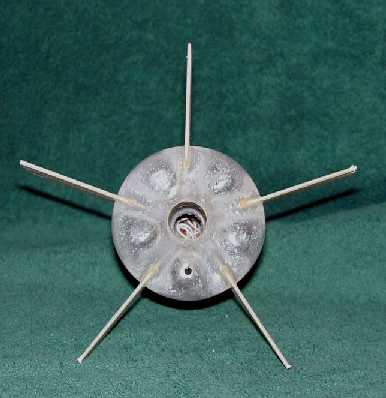

This can be fixed by adding a few rubber bands (wrapped around) where the water or air is leaking to help create a better seal. With the high pressure, the hoses have the potential to leak. I'm sure I could launch more rockets per year, but the rubber stopper tends to dry-rot after so many years. I can usually go for about 3 years (launching 70-80 rockets each year) before the rubber stoppers wear out. If the rocket launched well the first time, I might bump the pressure up to around 100 psi. This is where I allow them to test out different amounts of water/different air pressures/different launch angles. If the rockets are in good shape (still have fins/nose cone can be straightened out) they can launch again. When I do this activity with my students after everyone has had a chance to launch the kids can retrieve their rockets. You will need a large area to launch over (football field or soccer pitch). Stand back, pull the string with a quick flick of the wrist, and watch it fly. If you use an air compressor, getting the pressure up to around 90 psi only takes about 10 seconds. You could use a bicycle tire pump, but it takes a lot of work and the time between launches increases. The launch kit has a valve for pumping up the bottle (like you would find on a bicycle). This is approximately 2 Solo Cups worth of water.Ĭonnect bottle to the launch kit (This can take some practice because it takes some leverage to get the rubber stopper into the mouth of the bottle).Īfter the bottle is secured to the launch kit, pressurize the bottle. (It's good to have a hose spigot close by and a 5-gallon bucket). I have used THIS KIT for many years and find the quality of the materials built to last.įirst, add about one liter of water to the BOTTOM BOTTLE. Some design changes, like shorter suspension lines, lightweight material, and neat folding techniques, can help speed up the deployment of your parachute.There are a number of different launch set-up kits that can be purchased online.

This takes time, so if your rocket does not reach enough altitude, your parachute might not have enough time to open up and do its job. For a bottle rocket, air resistance has to knock off the nose cone, causing the suspension lines to unravel and the parachute to unfold. Parachutes are used to slow down the fall of a rocket to reduce the risk of damaging the rocket as it touches the ground. More mass leads to a larger force pulling the rocket down, resulting in a lower apogee. A more aerodynamic shape reduces drag, which means less force slowing the rocket down, which results in a higher apogee.

Creating more pressure in the bottle before launch will increase the thrust, and thus lead to a higher apogee. The highest point of the flight path is often called the apogee. In rocketry, the force that pushes the rocket forward is called thrust, and the air resistance is called drag. Scientists use several units to quantify pressure, but it is mostly commonly expressed in pounds per square inch (psi) on your bicycle pump. Just like with the fire hose, the more pressure that is put on the water, the faster the water comes out and the bigger the push on your bottle rocket. You should have been able to deploy a parachute, even when packed in a nose cone, when using 40 psi pressure at launch. If you pack the parachute in a nose cone, make it lightweight so it blows off easily. To keep the deployment time short, pack the parachute neatly and keep the suspension lines short. This all needs to happen before the parachute touches the ground. The additional mass, and the change in the rocket's aerodynamics will slightly change the maximum altitude the rocket can reach.Ī bottle rocket does not have a parachute ejection system like real rockets, so the air has to push off the nose cone if there is one, allowing the suspension lines to unwind and the parachute to unfold. If the nose cone was heavy compared to the mass of the rocket, you might have observed a decrease in altitude.Īdding a parachute adds some mass, but it considerably increases the chance to recover the rocket undamaged. Unfortunately, a nose cone adds some mass to be pushed up. A rocket with a nose cone has an easier time pushing the air aside and making itself a path through the air, and thus, it usually reaches a higher altitude. When you cranked up the pressure inside the bottle from 20 psi to 40 psi, your rocket probably reached a higher altitude.īy adding fins-even small fins-you probably noticed the rocket took a straighter path to its highest point (the apogee), and no longer tumbled down, but flew straight down.īy adding a pointy, sleek nose cone, you made the rocket more aerodynamic.


 0 kommentar(er)
0 kommentar(er)
